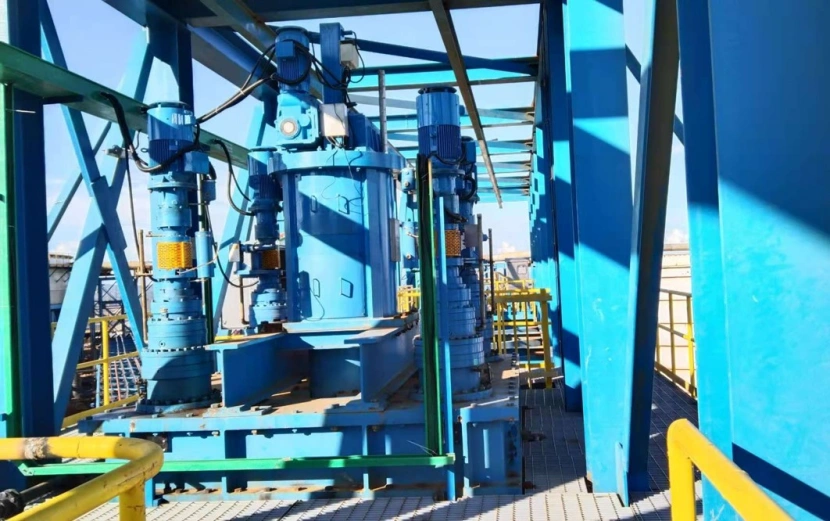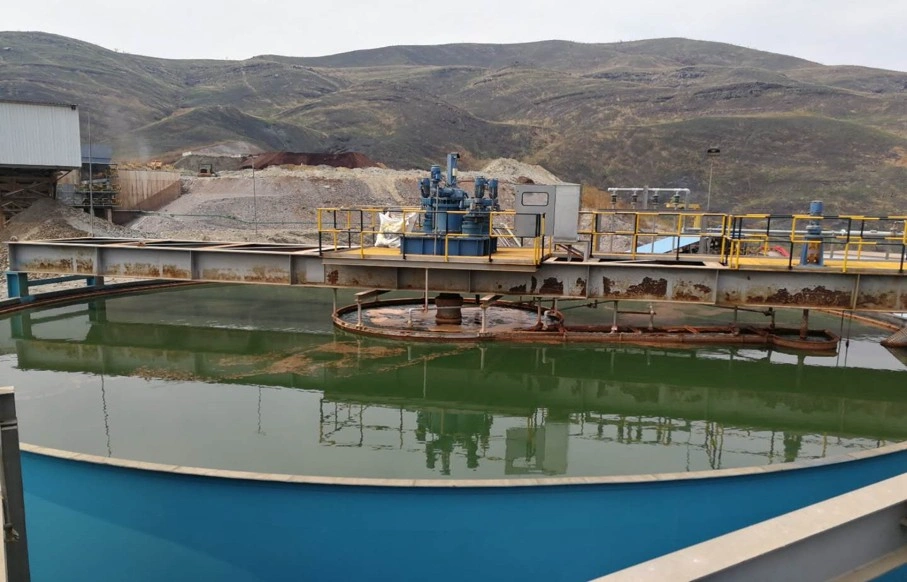Thickener technology is crucial in today’s mineral processing. It enables effective separation of solids and liquids. This process supports water reuse, tailings management, and better plant performance. As environmental rules get tougher and costs climb, understanding thickeners is vital for mining workers and plant managers.

Overview of Thickener Mining
Thickeners are key equipment in the mining world. They are widely used in mineral processing plants. Their main task is to separate solids from liquids through settling.
What is Thickener Mining?
Thickener mining uses special machines to thicken slurry. It removes extra water to make slurry denser. This method is common in gold, copper, iron, and rare earth processing.
The Role of Thickeners in Mineral Processing
Thickeners act as gravity-driven equipment. They split a solid-liquid mix into clear liquid (overflow) and thick slurry (underflow). Also called sedimentation tanks or rotating rakes, they are used after grinding and flotation. They help reuse water and shrink tailings volume.
Key Benefits of Using Thickeners in Mining Operations
Thickeners improve efficiency. They reduce water use and cut energy costs for later dewatering steps. They also lessen environmental damage. By thickening slurry, they can save millions in profits. Without thickeners, evaporating water from slurry would take far more energy.
Core Components and Structure of a Thickener
To understand how thickeners work well, we must look at their main parts. Each part helps achieve good separation.
Main Structural Elements of a Thickener
A thickener has several key pieces. These work together for smooth operation.
Tank and Rake Mechanism
The tank holds slurry for settling. A rake mechanism moves slowly at the bottom. It pushes settled solids to a central exit point. This keeps the tank bottom from clogging with hardened solids.
Feedwell and Underflow Discharge System
The feedwell spreads incoming slurry evenly. It reduces turbulence to aid settling. Settled solids collect at the bottom. They exit through an underflow outlet.
Drive Head and Torque Sensor
The drive unit powers the rake arms. Modern thickeners include torque sensors. These track stress in real time. NHD’s torque indicator spots changes during operation. It adjusts settings to balance settled mud and discharged slurry.
Types of Thickeners Used in Mining
Different thickeners meet various mining needs.
Conventional Thickeners
These basic units handle smaller volumes. They rely only on gravity for settling. Their design is simple yet effective.
High-Rate Thickeners
High-rate thickeners have better feedwells and flocculation zones. These speed up settling compared to basic models. They process more slurry in less time.
High-Density and Paste Thickeners
These advanced units create very thick underflows. They can raise slurry solids from 55% to 70%. Few companies worldwide can achieve this high concentration.
The Operational Process of a Thickener
Knowing how thickeners function helps operators manage them well under different conditions.
Slurry Introduction and Flocculation Process
Slurry enters through the feedwell. Special chemicals, called flocculants, are added. These group tiny particles into larger clumps. As a result, settling happens faster. Most modern setups use flocculation to boost settling speed by many times.
Gravity Sedimentation and Solids Settling
Inside the tank, heavier solids sink due to gravity. Meanwhile, clear liquid rises to the top. This separates solids from water effectively.
Collection and Discharge of Underflow Slurry
Rakes guide settled solids to a central exit. The thick underflow is then pumped out. It can be used further or disposed of.
Overflow Clarification and Reuse of Water
Clear water flows over the tank’s top edge into channels. This water can be reused in earlier steps or safely released.

Factors Influencing Thickener Efficiency
Several factors affect how well a thickener performs. These need careful control.
Feed Characteristics and Solids Concentration
Changes in particle size or slurry thickness impact settling. For example, high clay or very fine particles may need more flocculant.
Flocculant Selection and Dosage Control
Choosing the right flocculant is critical. Correct dosing ensures fast settling without wasting chemicals.
Rake Torque Management and Bed Level Control
Tracking torque prevents damage from too much mud buildup. If an alarm sounds or the motor stops, production halts until the rake is lifted.
Monitoring, Automation, and Process Optimization
Advanced systems like DCS (Distributed Control Systems) monitor bed level, torque, slurry thickness, and water clarity. NHD serial thickeners with DCS track materials in all directions.
Challenges in Thickener Operation
Thickeners offer benefits but face challenges. These require smart solutions.
Common Operational Issues in Thickening Systems
This section explores major problems in thickener operations.
Torque Overload and Mechanical Failures
Too much mud can stress rake arms. This may cause motor failures or structural damage if not fixed quickly.
Inconsistent Feed Rates or Solids Content
Varying feed conditions disrupt flocculation. This leads to poor settling or dirty overflow water.
Poor Flocculation Performance
Bad mixing or wrong chemicals slow settling. This can also increase chemical use.
Strategies for Troubleshooting and Performance Improvement
Solutions include automated torque monitoring systems. Optimized dosing pumps help too. Regular checks on rake mechanisms are key. Predictive algorithms, based on past data, also boost performance.
Environmental Considerations in Thickener Use
Modern mining emphasizes sustainability. Thickeners support these goals directly.
Water Recovery and Recycling Benefits
Thickeners reclaim much water from tailings. This reduces freshwater needs, especially in dry or remote areas.
Tailings Management Through Effective Dewatering
Thicker underflows mean less tailings volume. This shrinks storage needs and lowers long-term environmental risks. Countercurrent washing cleans soluble parts from slurry.
Compliance with Environmental Regulations
Thickeners ensure clear overflow water. This meets strict discharge rules for reuse or release into nature.
Applications Across Mining Sectors
Thickeners work across many ore types and processes worldwide.
Use in Gold, Copper, Iron, and Other Mineral Processing Plants
Thickeners are vital in gold leaching and copper smelting. They fit into many hydrometallurgical processes. For example: Φ30m Leaching Thickener and Φ45 Thickener for Copper.
Integration with Tailings Storage Facilities (TSF)
High-density paste thickeners reduce TSF risks. They create stackable tailings with less seepage. This aids mine closure planning.
Role in Sustainable Mine Water Management
Thickeners in closed-loop systems cut environmental impact. They improve resource efficiency in mines globally.
NHD: A Trusted Supplier for Industrial Filtration and Separation Solutions
NHD leads the industry with advanced thickening solutions. Their innovative engineering tackles global mining challenges.
Overview of NHD’s Product Offerings
NHD’s products include:
- Filter Series & Automatic Press Filter Series
- Agitator & Thickener Series for Mining Applications
- Equipment for Sulfuric Acid Industry & Pressure Vessel Series
- Desulfurization Equipment Series & Filter Cloth Series
- Material Series for Industrial Use
NHD-serial deep cone thickeners advance alumina tailings treatment. Their patented lifting rake ensures steady operation, even with thick sludge. This delivers reliability during constant production.
Commitment to Quality, Innovation, and Industry Standards
NHD meets global standards, like Australian AS/NZS codes. Their duplex stainless steel tanks handle seismic conditions. These solutions ensure strong equipment and faster construction. NHD has earned praise from clients in Australia, Russia, DRC Congo, Indonesia, and more.

Conclusion
Thickeners are essential in mining. They enable efficient solid-liquid separation and support green operations. This guide has covered their structure, processes, types, challenges, and benefits, such as water reuse and tailings handling. From basic to high-density models, proper use improves performance and cuts costs. NHD’s Agitator & Thickener Series, with features like torque sensors and deep cone designs, solves issues like overloads and uneven feeds. By mastering thickeners and working with suppliers like NHD, mining experts can boost efficiency, meet environmental rules, and ensure long-term success.
FAQs
Q1: What is the main purpose of a thickener in mining?
A: Thickeners separate solids from liquids. They recover reusable water from slurries and concentrate solids for disposal or further use. This boosts efficiency and supports sustainable practices in mining.
Q2: How does a high-rate thickener differ from a conventional thickener?
A: High-rate thickeners have better feedwell designs and flocculation zones. They settle slurry faster than basic models. This allows higher throughput in smaller spaces without losing water clarity or slurry thickness.
Q3: Can thickeners be used for all types of mining operations?
A: Yes. Thickeners work with many ores, like gold, copper, and iron. They also handle non-metallics, like alumina red mud or phosphate waste. This makes them vital for mineral processing plants worldwide.

